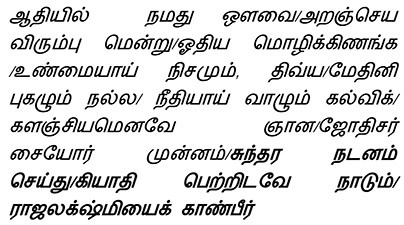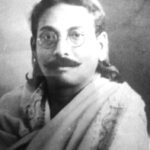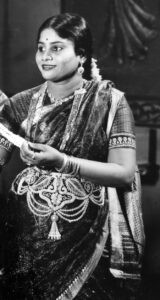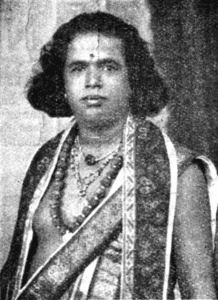According to Theodore Baskaran, “We can say with certainty that songs are a unique feature that differentiates Indian cinema from the cinema of other countries.” (Faces of Tamil Cinema). It is true that early Tamil talkies were essentially “singing films”. This is also why there was a misconception about the film Kalidas.
The arrival of talkies brought stage actors and other performers into cinema not just in Tamil, or even just in India, but all over the world. As a result, many theatrical elements were present in cinema. Outdoor scenes were rare, and one could say they were the only thing that truly differentiated these films from plays. In plays and Kathakalakshepam (a form of religious storytelling with music) of that time, songs were abundant. It was a common practice for men performing Kathakalakshepam to add the title Bhagavatar to their names. Women added Bai, as the first woman to take to the art was C Saraswati Bai. Interestingly, she called herself the First Lady Bhagavatar.
In the early 1930s, films were essentially recordings of stage plays. The stage and screen were inseparably linked, much like “light and sound”. When Kalki wrote about the film Kalidas, he described it as a play. In documents like songbooks, details about actors were listed as dramatis personae. Because songs were paramount in cinema, aspects like acting and physical appearance were not given much consideration. Artists frequently moved between theatre and cinema. Although many theatrical elements existed in cinema, we will focus on a few related to songs here.
In every film advertisement, the number of songs featured was highlighted as a primary attraction. Before the states were reorganised based on language, when it was a united Madras Presidency, films from all South Indian languages were screened throughout the province. However, in the 1930s, the number of films released in Kannada and Malayalam was very less. The songs, interspersed with music, served as a compelling feature that transcended the language barrier.
Just as stage plays began with an introductory song that identified the theatre company and wished for its success, the same thing happened in cinema, even for mythological films.
The opening song of the film Kalidas, sung by TP Rajalakshmi, began like this:

In the mythological film Radha Kalyanam, the introductory song featured a paradoxical English phrase ‘Meenambigai Talkies’ in the title Tamil song.
Similarly, just as plays ended with a national anthem or a benediction (mangalam), the same was true for films. The final song of the mythological film Bhama Vijayam (1934) was “Jana… Gana… Mana…”
According to my friend Akila Vijayakumar, the title songs should not be considered part of a film’s songs.
Musical Concerts
So, when did songs become so dominant in plays?
T.C. Vadivelu Nayagar gave us an idea in his The Life Story of Cunnaiah – “Acting, which was once the primary element of plays with music as a secondary tool, was no longer so. Theatres turned into concert halls and actors cleverly spoke relevant and irrelevant words as the situation demanded, singing popular songs while performing the plays.” As the audience’s preference for music-focused plays grew, theatre companies decided to present them, hoping to eventually change the public’s mindset.
The famous Cunnaiah Company, for example, saw a decline in revenue and popularity because it lacked singers. It was at this point that Cunnaiah recruited SG Kittappa (1906-1933). The future star was only 14 years old then, which makes it clear that this shift towards an abundance of songs in plays occurred around the 1920s.
Kalki also wrote in Ananda Vikatan (04.08.1935):
“In our country in the past, music was not considered a mere pleasure without a purpose. It was experienced in combination with bhajans, kathakalakshepam, plays, and dances.” So, why would cinema be any different?

Poet Baskara Das.
Reading poet Baskara Das’s diaries reveals a common trend: it seems that it was a widespread, daily event for people, including ordinary citizens, to write and sing songs.
The Quantity of Songs
Plays were so filled with music that the word Sangeetha (Musical) prefixed their names, as in Sangeetha Kovalan and Sangeetha Lava Kusa. Songs were often included in inappropriate situations. Sometimes, as soon as one song ended, another would begin without any break. If an average song lasted about two minutes, a film with 50 songs would need to dedicate an hour and 40 minutes to just the music. Roughly two-thirds of the film’s runtime was taken up by songs.
Because dialogue was sparse and often replaced by songs, simply reading the songbook for a film was enough to understand what a now-lost film was like. For example, the film Krishna Leela, released in 1933, had 60 songs.
Tamil Tunes
Songs were frequently set to popular, recurring tunes, including Hindustani melodies. Songbooks often included notes on the specific tunes used. Hindi songs were also part of this mix; for example, in the 1934 film Pavalakodi, Shanthadevi performs and dances to a Hindi song, though it is not listed in the film’s songbook.
Tamil melodies were also reused extensively. We are familiar with the song Naadagamellam Kanden Undhan Aadum Vizhiyile from the 1956 film Madurai Veeran. The same tune was used in Pavalakodi. (It is well known that Papanasam Sivan handled the songs and music direction for the film, but a noteworthy and rare piece of information is that the orchestra and background music were handled by Srimathi G. Visalakshi Ammal.)
There’s also a film titled Bhakta Thyagaraja, which is in Tamil, but Tyagaraja never composed kriti-s in Tamil. Out of the 32 songs in the film, there is only one Tamil song, which, according to the story, is sung by thieves.
Gramophone and Cinema
In those early years, film songs were not yet being released as gramophone records. Long before talkies arrived, records had been in circulation – from 1905 at least. Vocal and instrumental music was released on gramophone discs, which were a popular form of entertainment at the time. Later, entire plays, complete with musical arrangements, were recorded and released.

PS Siva Bhagyam – Pandurangan movie, 1939.
Because of this, individuals who were famous from these records gained entry into cinema. Their identity was often tied to the company they recorded for. Comic and folk songs were very popular on these records. Many of these performers entered cinema and sang and acted in the same style. These songs were the only ones that reflected the colloquial language of the time. For example, the song Naan Madhichiyathile Kudiyirukkirathu sung by PS Siva Bhagyam is still available today. Kalki praised it, calling it The Milkmaid’s Song in a 1933 issue of Ananda Vikatan. The song was also featured in the film Krishna Leela (1933). PS Siva Bhagyam was even credited in cinema as “Odeon-fame Siva Bhagyam.” Cinema provided the opportunity to see and enjoy the songs and singers that people had previously only heard. One cinema advertisement even noted that a movie ticket cost less than a gramophone record.
Unfortunately, the vast majority of films released over a twenty-year period, from 1931 to 1950, have been lost. Songbooks containing the lyrics from gramophone recordings were sold both individually and along with the records. Some songs from films in 1932-33 were included in gramophone song lists, noted as “songs sung in so-and-so talkies,” but they were given no record number – only the lyrics were provided.
However, some songs from films released in the late 1930s were put on records, and a few of these have survived to this day. The service provided by those who have uploaded them to social media is commendable. These recordings serve as a form of proof for films that are no longer available. The print on the records, indicating the song, singer, and film, acts as an additional documentation. Photographs of the cast and crew can also be seen on the record sleeve covers.
One document claims that the first Indian film song ever recorded on a gramophone was from the 1934 film Puran Bhagat, a song titled Javo Javo sung by the blind actor K.C. Dey. Old documents like the Cinema Diary state that the first South Indian film to be featured on a gramophone record was Sethu Bandhanam, released in 1937. (The question of why it took so long is valid!) However, we can see from contemporary advertisements from as early as 1936 that songs from films like Pattinathar were already being released on records.
In a 1933 issue of Ananda Vikatan (in the Kalki Kalanjiyam collection), Kalki wrote that “talkie plates are being released.” At the time, only five Tamil films had been released: Kalidas (can it be called a Tamil film?), Harischandra, Galava, Parijatha Pushpaharanam, and Ramayanam. Kalki’s note also indicate that Savitri was running in theatres in 1933. However, he doesn’t specify if the records contained just songs or were from Tamil talkies. This is an important distinction because, in those early years, film songs were not yet being released as gramophone records.
Nevertheless, one song sung by TP Rajalakshmi from the 1933 film Valli Tirumanam is still available on social media. It may have been taken from a stage play or from the film later on. Rajalakshmi continued to act in stage productions of Valli Tirumanam even after the age of 40 (Nadaga Kalaimanigal by Sattaampillai Venkatraman). Company advertisements show that the film was still available after 1937. The song by PS Siva Bhagyam mentioned earlier was not taken from a film, and there is evidence to support this. As far as I know, these two are the oldest surviving Tamil film songs.
With an average of 40 songs per film, not all of them were recorded on gramophone records. Only a select few were. In the 1930s, a record could hold only about three minutes of audio per side. We’ve seen that songs ranged from two to 20 lines. Songs that were longer than three minutes were continued on the other side of the record. For example, the song Oru Mada Maadhu… from the film Pattinathar was a long song. Some songs in Pattinathar were noted as having a “prose-like style”, and they sound exactly that way in the recording.
Initially, there was no technology to directly transfer audio from a film recording to a record. Therefore, the same singers who performed in the film had to re-record their songs at the gramophone company. Sometimes, other singers would re-record the songs for sale. This also helped some singers get their start in cinema. When songs didn’t fit into the three-minute limit, they were altered to fit the format.
Playback
Initially, the only option in cinema was live sound recording. Dialogue, songs, and background music were all recorded simultaneously during the shoot. To avoid unwanted ambient noise, they often filmed at night and set up studios in the outskirts of cities. The musical troupe would hide from the camera’s view while playing their instruments.
Opening songs, where title cards appeared on screen while a song played in the background, were often treated as disembodied voices (asariri). Documents from the 1939 film Thyagabhoomi, which is still available, mention that DK Pattammal and Vatsala provided the background vocals. However, these were not lip-synced playback but asariri songs. This technique can be seen in the opening song of Pavalakodi (1934), one of the oldest surviving Tamil films. Interestingly, this song is also not included in the film’s songbook.
It appears that the technology for using playback singers was introduced as early as 1935 (in films like Bhagya Chakra/Dhoop Chhaon). However, it is widely believed that this technique was first used in Tamil cinema with AVM’s film Nandakumar, released in 1938.
Actors who could not sing in their own voices were limited to small roles. A prime example is MGR, who made his debut in 1936 but struggled to make a significant impact for over a decade because of this.
Radio
Radio was in use even before talkies became widespread. In Madras, the Madras Presidency Radio Club (1924), was followed by a radio station set up by the city corporation, but its broadcasts had a limited range and did not include film songs. It was only in 1938 that All India Radio (AIR) was officially established in the city, followed by another station in Trichy.
Even with the launch of AIR, film songs were not broadcast for a few years. Once they were, however, it became much easier for people to listen to the songs, which in turn helped them gain widespread popularity. Entire films were also broadcast as radio plays. As a result, artists moved between both mediums — those who gained fame on the radio transitioned to cinema, and vice versa.
Aesthetics

Mani Bagavatar.
The songs of that era were not simple. Their language and compound words were complex, making them difficult for everyone to sing and enjoy. Yet, this dominance of songs in Tamil cinema lasted for approximately 20 years. Does it really take about two decades for a trend to completely change? We can see evidence for this in our own time.
Today, it’s a matter of some wonder and doubt for us whether Carnatic music had such a broad appeal among the masses. However, SV Venkatraman, an actor and composer from that time, affirms that it did. During the period when songs were given priority, those from traditional families (especially Brahmins) who had trained in Carnatic music did not find success in cinema. (More research may be needed to understand this.) Instead, it was stars from the theatre, like MKT Bhagavatar and PU Chinnappa, who rose to the top.
The Last Bhagavatar
The large number of songs and the dominance of the Bhagavatars that characterised the 1930s began to decline in the 1940s with the widespread adoption of playback singing. KA Chokkalinga Bhagavatar can be considered the last Bhagavatar to act in Tamil cinema. He trained at the Madurai Original Boys Company and had been acting since the 1930s. He can still be seen in the role of Narada in the film Rambaiyin Kaadhal (1939). During the Bhagavatars’ reign, only those who had a strong command of Tamil or were ethnically Tamil became superstars.
— by S.A. Muthuvel (muthuvelsa@gmail.com)